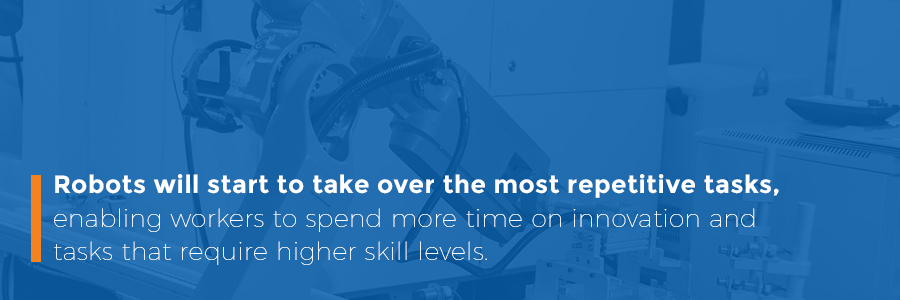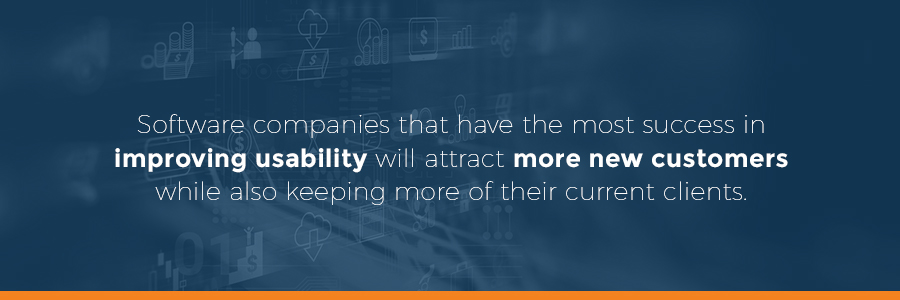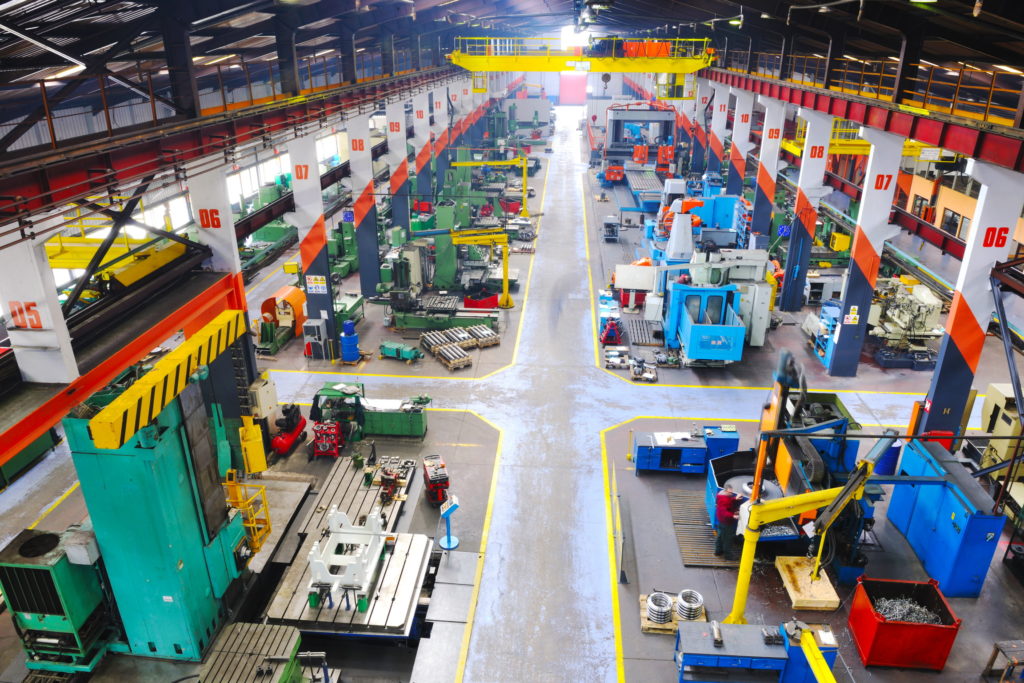In 2017, manufacturing companies increased their use of industry 4.0 technologies — such as connected devices, big data analytics and automation — in an effort to increase productivity. And, they succeeded, according to a recent survey that found 77 percent of companies boosted their revenue by automating core parts of their operations. This helped them to navigate changes in the economy, workforce and political and natural environments.

Many of these trends will continue to gain relevance in 2018. Various industry 4.0 tech will see more widespread adoption, and companies will begin to refine the strategies they use to manage those technologies. The manufacturing sector will also begin to explore potential uses for other newer advanced technologies. This will impact virtually every part of the industry, from jobs to the supply chain. Plus, economic, societal and political trends will continue to shape the manufacturing sector as they did in 2017.
So what manufacturing trends can you expect in 2018?
Here are 12 things to look for.
- The Industrial Internet of Things (IIoT)
In 2018, we’ll see the continued growth of the internet of things (IoT), which enables all sorts of devices to collect and access data by communicating via the internet. The subsection of this network that concerns manufacturing is the industrial internet of things (IIoT), which is projected to encompass an estimated 200 million devices with a value of more than $280 billion by 2019.
These industrial connected devices can include a wide range of machinery, tools, products and vehicles. In fact, you can now place a sensor on virtually everything on the factory floor. In 2018, businesses will start to get a better grasp on which items they can get the most benefit from if they equip it with sensors. Shortening time-to-market and mitigating supply chain risks will likely be the most common uses.
Companies that focus on distribution and rely on efficiently moving inventories and introducing products in coordination with other facilities will find IIoT especially useful, as it will improve accuracy, efficiency and quality. Companies will also continue to use it to cut costs by optimizing facility and equipment performance.
- Automation
The robotics market is expected to reach $87 billion by 2025, with $24.4 billion of that coming from the industrial sector. In 2018, manufacturers will continue to move toward that level of automation adoption.
Much of the conversation about robotics centers around it taking jobs from humans. We may see some of that in 2018, but it will be a longer-term trend. This year, automation will more so create a shift in the responsibilities of human workers, rather than eliminate their jobs.

Robots will start to take over the most repetitive tasks, enabling workers to spend more time on innovation and tasks that require higher skill levels. Manufacturing workers will also start spending more time overseeing and managing automated systems. This technology can also improve workers safety by taking over the riskiest parts of many jobs. To make the most of automation and avoid job displacement, manufacturing companies may begin to develop strategies for retraining their workforce to work alongside robotic equipment.
- Cloud Computing
Cloud computing, which allows data, software and other facilities to be stored off-site and accessed via an internet connection, already plays a role in the manufacturing sector. Throughout this year, the industry will continue to use this technology while also beginning to refine their cloud strategies more. Businesses that use cloud computing will start to figure out what information works best with cloud computing, as well as what data should be stored and managed on-site.
The cloud will also continue to narrow the gap between large companies and small ones. This is because it allows even small businesses to access world-class technologies by significantly reducing the upfront investments required.
Many businesses will likely use the cloud for IIoT technology because of the high volume of data it creates, enabling more companies to benefit from connected devices. Cloud-based security solutions that monitor network traffic for potential risks and block unsafe traffic will also be prominent.
- Better Metrics and More Intelligent Decision-Making
IIoT, automation and cloud computing will allow for more intelligent decision-making and drive a change in manufacturing performance metrics. Through the use of these technologies, businesses can gain access to real-time data, as well as a larger volume of information. Businesses can use this information to inform decision-making through predictive analytics.
Manufacturers will be able to record data from individual pieces of equipment, combine it all into a single database and analyze it with the use of artificial intelligence technology to derive more valuable insights than they could have in the past.
To take advantage of these technologies to the highest degree, companies will need to decide what data to track, as well as how to track, manage and analyze it. Businesses using smart technologies will start to get a better idea of what data strategies work best for them. This trend will also increase the demand for workers who can understand and work with this data, as well as extract the most value from it for their employers.
- Augmented and Virtual Reality
Another group of industry 4.0 technologies that will begin to play a larger role in 2018 is that of augmented and virtual reality. Companies have just begun discovering how they can use these tools, and this exploration will continue throughout this coming year. Companies are exploring and testing how they can use AR for training, improving access to information on the factory floor and assisting the product development process.

More potential applications may rise to the surface in 2018. However, this technology is a bit behind IIoT, automation and cloud computing when it comes to adoption in the industrial sector. It will likely take a few years before we see widespread use of AR and VR among manufacturers.
- 3D Printing
3D printing is another advanced technology on a similar timeline as that of AR and VR. It will take a few years before manufacturing companies use it widely, but they’re starting to discover and test out various applications.
3D printing, also called additive manufacturing, will likely make the most significant impact during the prototyping phase of product development and manufacturing. Businesses with 3D printers, whether they’re in-house or nearby — can more quickly and economically produce multiple versions of prototypes. They can test out multiple products designs, as well as easily access design files and alter them, perhaps combing the best aspects of various prototypes. This capability may improve product quality and lead to faster, more affordable prototyping processes.
It also has implications for customization. Companies that use 3D printers can more easily and affordably produce a small amount of a customized item. They may even be able to produce one-of-a-kind items based on a customer’s specifications.
3D printing systems are becoming more scalable, making them more suitable for large-scale manufacturing procedures. As additive manufacturing technology continues to improve and manufacturers explore and test more potential use cases, 3D printing will likely start to play a more substantial role in the manufacturing sector.
- Software Usability
All of these advanced technologies are complex, which can be intimidating for businesses and make adopting them a costly undertaking. This year, manufacturing software providers will start to focus on improving the user experience for their customers, as well.
User interface designs will improve, and software will become more customizable and flexible to better fit the needs of various manufacturers. These improvements will support the increasing prevalence of a variety of advanced technologies and software platforms, especially among smaller operations that may not have the resources to manage more complex systems. Software companies that have the most success in improving usability will attract more new customers while also keeping more of their current clients.

- Integration and API
To get the most out of all of these technologies, which are often hosted in various locations, manufacturers need to integrate them with each other and their existing processes. Application Programmer Interfaces (APIs) will be one of the most prominent technologies that empower them to do this.
APIs are a set of tools that allow two or more platforms to communicate and share information with each other. They help businesses coordinate their technology use and data collection by combining all the gathered information and allowing businesses to obtain more valuable insights. With a quality API in place, manufacturers can launch and scale new processes, technologies and business models more quickly.
APIs are just beginning to play a central role in manufacturing, and 2018 will be the year they really start to pick up steam.
- A Focus on Supply Chain Risk Management
In the coming months, managing and reducing supply chain risks will become a higher strategic priority for manufacturers, especially as the frequency of natural disasters, political tensions and other conflicts increases worldwide. Smart technologies will help businesses better manage their supply chains.
Manufacturing companies will update their quality management and compliance strategies and increase their collaboration with suppliers in order to lessen risk. Management will likely set higher standards for quality and work to increase the accuracy of demand forecasts.
The data and insights gathered through smart technologies will help businesses obtain more precise, real-time information that paints a clearer picture of their supply chains. These technologies will also help them keep better track of their inventory and demand, improving their forecasts and supply chain efficiency. Since this information will come in closer to real time, manufacturing will be able to respond more quickly and effectively to changes.
- Green Manufacturing
Another ongoing shift that will continue throughout 2018 is the move toward more sustainable manufacturing practices. Increasingly, green manufacturing is becoming a smart, money-saving business strategy, as well as an environmentally and socially responsible way to run your business.
Eco-friendly manufacturing practices include repairing equipment rather than replacing it, reducing and reusing waste, using energy more efficiently and getting more power from renewable energy sources. More and more large companies are installing solar panels on their facilities or buying renewable energy from nearby facilities.
These practices can all reduce costs and improve your business’s reputation among consumers. As more people start to prioritize sustainability in their shopping, companies with a reputation for being green will prosper. Going green can also help a business achieve compliance with relevant standards, as well as certifications that improve their reputation and expand their opportunities.
- Reshoring
The manufacturing sector has recently seen a reversal of the offshoring trend, which has come to be called reshoring. This shift will likely continue into 2018.
As wages rise overseas, the savings associated with offshoring are decreasing. When factoring in the shorter supply chain and distribution times producing goods domestically allows, the advantage of overseas manufacturing becomes even less pronounced.
Making your products in your home country can also improve the public’s perception of your company and increase the revenue you earn from selling your goods. According to Consumer Reports, 80 percent of Americans prefer to buy items made in the United States — in fact, 60 percent will pay 10 percent more for them.

- Job Growth
Bringing more manufacturing back to U.S. soil, of course, means creating more jobs. In 2017, the number of U.S. manufacturing sector jobs grew by 1.6 percent after little change in 2016. The Bureau of Labor Statistics, however, projects that U.S. manufacturing jobs will decrease by 0.6 percent between 2016 and 2026. The job market is influenced by many different factors and can change rapidly, which makes forecasting difficult, but the manufacturing industry will most likely see a slight increase in jobs this coming year.
One thing that will continue to change is the nature of manufacturing jobs. Robotics will take over many of the more repetitive and dangerous parts of industrial work, allowing workers to spend more time on more cognitive, creative tasks. Employers in the manufacturing sector will also be looking to fill positions dealing with data analytics and other aspects of industry 4.0. Companies are expected to face a skills shortage in this area, which will boost wages for the workers who can do this kind of work.
What Will 2018 Bring?
2018 will be a year of continued technological advancement, an increasing focus on sustainability and a growing and changing job market for the manufacturing sector. More companies will start using advanced technologies, and those that already use them will start using them more effectively, driving changes across the industry.
Although we can make informed predictions about the kind of year manufacturing will have, there are bound to be some surprises, too. Only time we tell exactly what happens in the manufacturing industry this year. What shifts are you expecting to see?
To stay up to date with the latest manufacturing industry trends, learn about manufacturing technology and get tips on how to run an effective plant, subscribe to the Global Electronic Services blog.
